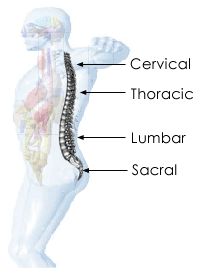Know Your Spine
The spine is one of the most vital parts of the human body. What organs are affected by specific vertebrae in the spine?

Upper Neck, Upper Cervical Spine (C1 - C2)
- C1 - Brain, Nasal and Palette Glands, Lungs, Heart, Spleen, Kidney, Stomach, Liver, Large Intestines
- C2 - Eye, Sinuses, Brain, Nasal and Palette Glands
Mid/Lower Neck, Cervical Spine (C3 - C7)
- C3 - Eye, Sinuses, Nasal and Palette Glands
- C4 - Eye, Sinuses, Nasal and Palette Glands, Sublingual Glands, Submaxilary Glands
- C5 - Parotid Gland, Sublingual Glands, Submaxilary Glands
- C6 - Parotid Gland, Thyroid
- C7 - Thyroid, Lungs
Mid Back, Thoracic Spine (T1 - T12)
- T1 - Lungs, Heart, Parotid Gland, Carotid Artery, Pulmonary Artery
- T2 - Lungs, Heart, Parotid Gland, Carotid Artery
- T3 - Lungs, Heart, Stomach, Pulmonary Artery, Carotid Artery
- T4 - Liver
- T5- Stomach
- T6 - Pancreas
- T7 - Spleen
- T8 - Liver
- T9 - Adrenal
- T10 - Small Intestines
- T11 - Kidney
- T12 - Kidney
Lower Back, Lumbar Spine (L1 - L5)
- L1 - Large Intestines
- L2 - Large Intestines
- L3 - Large Intestines, Spleen, Bladder
- L4 - Large Intestines, Bladder
- L5 - Large Intestines, Spleen, Bladder
Basebone or Tailbone, Sacrum and Coccyx
- SACR - Large Intestines, Spleen, Bladder
Barometric Pressure: A detailed discussion of spinal and whole body neurology far exceeds the scope of this web site. However, I chose this page to discuss a very interesting aspect of neurology not widely appreciated, that of the effects of Barometric Pressure on the body.
Years ago, an acupuncturist named Chan Gunn, MD did some spectacular research on the effects of "supersensitivity" on the human body (Gunn, C; Prespondylosis and Some Pain Syndromes Following Denervation Supersensitivity, SPINE, Vol. 5 (2), 3/1980). Much of this was based on early research by Cannon (Cannon WB, Rosenbleuth A; The Supersensitivity of Denervated Structures, New York, The Macmillan Co., 1949, pp 1-22, 185). In a speech given at the International Conference on Acupuncture and Chronic Pain, September 27-Oct. 1, 1983, in New York (transcript referred to here), Dr. Gunn came right out and discussed the fact that after injury, our body undergoes "Cannon's Law of Denervation." This means that the local nerves at the injury site are themselves injures and "supersensitive" after the fact; up to 1000 times more sensitive than they used to be. With this supersensitivity, it explains why people feel such tenderness after the fact and why people with musculo-skeletal pain can predict barometric weather changes. This in turn, helps explain why injured people, especially those who have been repeatedly injured, have seemingly odd flare-ups of pain for no apparent reason.
More often than not, it is a low barometric pressure front moving in. But how exactly? Well, with less atmospheric pressure pushing in on us from the outside, microscopically the pressure inside our bodies pushes out more. It is minute, but enough to cause pain. We've all seen athletes who have had multiple injuries to the same area and subsequent surgery -talk about how that knee, shoulder, arm, whatever starts "acting up" when a storm front is coming. Remember, barometric pressure starts changing long before you see a dark cloud or the rain. So when you or someone you know starts having that old ache again when a storm is coming, this is why.